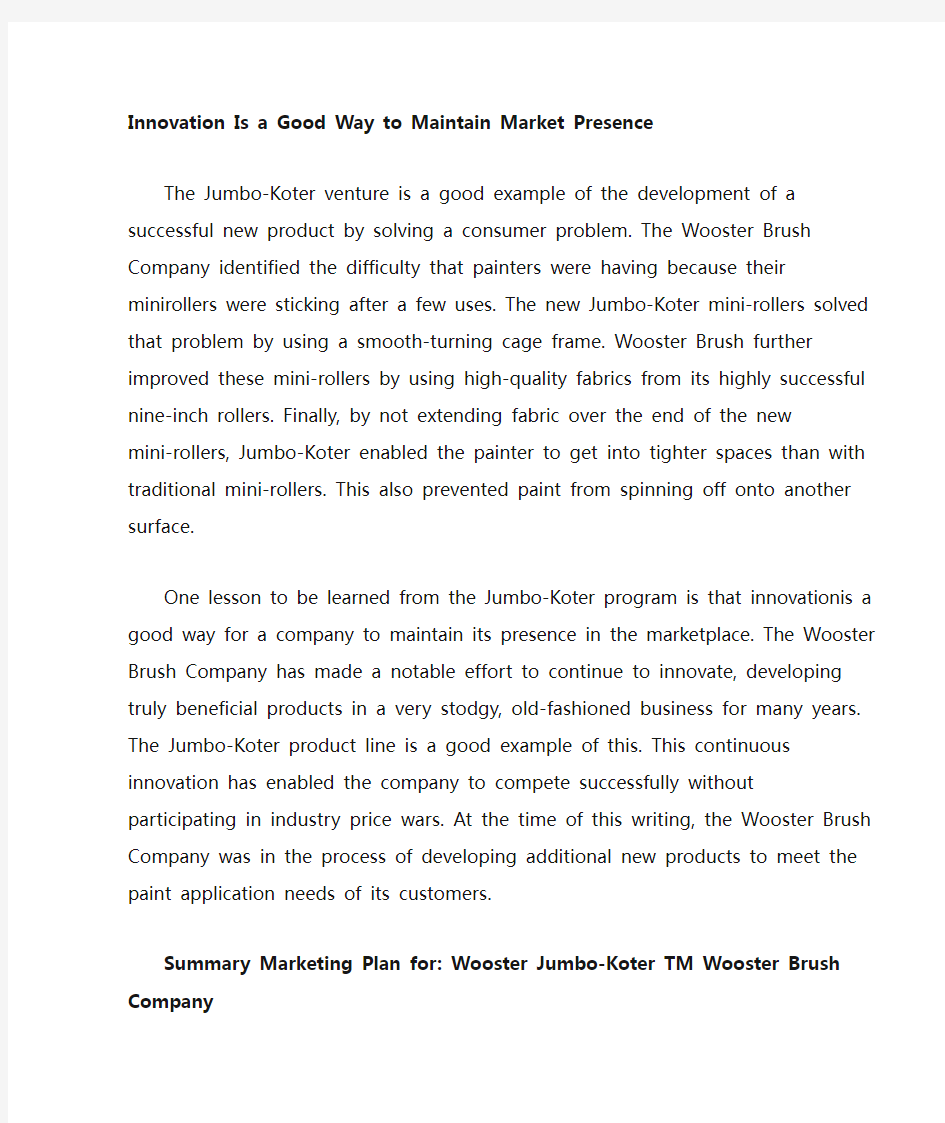
市场营销英文文献
- 格式:doc
- 大小:35.50 KB
- 文档页数:7


Innovation Is a Good Way to Maintain Market Presence
The Jumbo-Koter venture is a good example of the development of a successful new product by solving a consumer problem. The Wooster Brush Company identified the difficulty that painters were having because their minirollers were sticking after a few uses. The new Jumbo-Koter mini-rollers solved that problem by using a
smooth-turning cage frame. Wooster Brush further improved these mini-rollers by using high-quality fabrics from its highly successful nine-inch rollers. Finally, by not extending fabric over the end of the new mini-rollers, Jumbo-Koter enabled the painter to get into tighter spaces than with traditional mini-rollers. This also prevented paint from spinning off onto another surface.
One lesson to be learned from the Jumbo-Koter program is that innovationis a good way for a company to maintain its presence in the marketplace. The Wooster Brush Company has made a notable effort to continue to innovate, developing truly beneficial products in a very stodgy, old-fashioned business for many years. The Jumbo-Koter product line is a good example of this. This continuous innovation has enabled the company to compete successfully without participating in industry price wars. At the time of this writing, the Wooster Brush Company was in the process of developing additional new products to meet the paint application needs of its customers.
Summary Marketing Plan for: Wooster Jumbo-Koter TM Wooster Brush Company
MARKETING PLAN SUMMARY
BACKGROUND. Many painters have problems with their mini-rollers. Because these rollers are smaller than traditional rollers, they are great for getting paint into tight places and corners. On the other hand, the small size of the roller sometimes
causes it to stick after a certain number of uses. Painters often become frustrated when they have to drag a stuck mini-roller down a wall. This consumer problem led to a whole new product line called the Jumbo-Koter, and to a marketing plan that effectively leveraged the strengths of the Wooster Brush Company.
MARKET REVIEW. The paint applicator industry is made up of a relatively small number of companies, and it changes only slightly from year to year. A trend identified by Wooster Brush was the influx of foreign competition into the mini-roller market. Because of the effectiveness of using a mini-roller for detail painting jobs, the market for these small rollers was growing. As this was happening, several manufacturers were importing mini-rollers from China and other offshore sources. Wooster Brush was being forced to compete with these lower-priced imports.
CONSUMER USAGE AND ATTITUDES. A program of store interviews and personal observations enabled Wooster Brush management to determine that
mini-rollers were gaining market share and were eroding paintbrush usage more and more. Consumers represent the bulk of the unit sales; however, they tend to buy what is available and recommended in paint and hardware stores, and these stores typically display and recommend what is used by professional contractors. Through quantitative and qualitative research, Wooster Brush learned that painting contractors generally perceived Jumbo-Koter as a significant improvement over the mini-rollers that were currently available in the market.
PLANNING ASSUMPTIONS. Prior to launching Jumbo-Koter, the management of Wooster Brush made a series of assumptions regarding the outcome of the implementation. The following is a list of the key planning assumptions made by Wooster Brush Company:
Paint and hardware stores will generally accept distribution of Jumbo-Koter because of the success these retailers have had with previous new products from Wooster Brush.